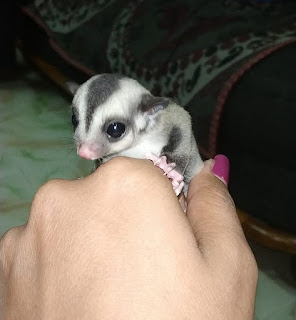 |
| Sugar glider |
Introduction
Sugar gliders, those captivating marsupials renowned for their gliding abilities and endearing personalities, have emerged as beloved pets among animal enthusiasts. If you're contemplating bringing a sugar glider into your home, it's imperative to arm yourself with the knowledge needed to provide optimal care. This comprehensive guide will delve deep into the realm of sugar glider pet ownership, encompassing every facet from their origin and dietary considerations to habitat arrangement, breeding processes, fostering bonding, and safeguarding their health. Let's glide right into the details!
Origins of Sugar Gliders
Sugar gliders, scientifically known as Petaurus breviceps, are native to Australia, New Guinea, and surrounding islands. These small marsupials are adapted to life in forested areas, where they use their membrane-like skin to glide from tree to tree in search of food and shelter.
Creating the Perfect Habitat for Your Sugar Glider
Constructing a habitat suitable for your sugar glider is pivotal for fostering their contentment and health. Optimal enclosures incorporate ample vertical space for climbing and ample branches to emulate their natural gliding habitat. Line their space with soft, cozy materials for comfort and introduce hiding spots to cater to their need for privacy.
Nutritional Mastery: Fueling Your Sugar Glider
A well-rounded diet is the cornerstone of sustaining your sugar glider's well-being. Their nutritional intake should encompass a well-balanced blend of fruits, vegetables, proteins, and specialized sugar glider pellets. Fresh water should remain readily accessible at all times. It's essential to avoid feeding them sugary or processed foods, as these can be deleterious to their health. Here's a sample food chart to consider:
- Fruits: Apples, grapes, papaya, mango
- Vegetables: Carrots, sweet potatoes, leafy greens
- Proteins: Cooked chicken, mealworms, crickets
- Pellets: High-quality sugar glider food pellets

mealworms, crickets
Breeding Process and Considerations
Breeding sugar gliders should be approached with responsibility and care. Breeding pairs need to be selected based on their health, compatibility, and lineage. Sugar gliders are marsupials; the female will carry her underdeveloped babies (joeys) in her pouch after birth. Successful breeding requires a suitable nesting environment and meticulous monitoring of the mother and joeys.
Cultivating Bonds: Nurturing Your Relationship
Sugar gliders are inherently social creatures that thrive on companionship. Building a strong bond with your sugar glider involves investing quality time, allowing them to acclimate to your scent and touch. Gradually, they'll develop trust and forge a profound connection with you.
 |
| cute |
Nocturnal Enigmas: Deciphering Sugar Glider Behavior
Operating on a nocturnal schedule, sugar gliders are most active during the nighttime hours. Grasping their behavioral tendencies is pivotal to creating an environment that caters to their natural inclinations. Respecting their sleep cycle and engaging with them during their periods of activity will contribute to their overall well-being.
Wellness and Joy: The Sugar Glider's Path to Health
Consistent veterinary check-ups, administered by a professional experienced in sugar glider care, are imperative to safeguard your pet's vitality. Routine health evaluations help preempt and address common issues such as dental complications, obesity, and nutritional deficiencies. Upholding a clean living space and offering appropriate nourishment are integral components of promoting their holistic wellness.
 |
| Healthy Diet |
Enrichment Unveiled: Sugar Glider Playtime and Toys
Endowed with intelligence and curiosity, sugar gliders necessitate mental stimulation. Furnishing a repertoire of toys, climbing structures, and interactive engagements staves off boredom and keeps them engrossed. Participating in play sessions entertains and strengthens the bond you share with your furry companion.
Conscientious Pet Guardianship: The Ethics of Sugar Glider Ownership
Embracing the role of a sugar glider owner entails ethical responsibilities. It's imperative to undertake thorough research prior to acquiring one, guaranteeing your capacity to fulfill their needs across their lifespan. Opt for adoption from reputable sources, shunning involvement in the illicit pet trade that jeopardizes their conservation.
Is a Sugar Glider a Good Pet?
Sugar gliders can make wonderful pets for individuals who are committed to meeting their unique needs. They are social animals that thrive on companionship and require a carefully tailored habitat, proper diet, and regular veterinary care. Consider your lifestyle, dedication, and willingness to provide the necessary care before deciding if a sugar glider is the right pet for you.
 |
| sugar glider |
What Can a Sugar Glider Eat?
A sugar glider's diet consists of a variety of foods that replicate their natural dietary preferences. They are omnivores, which means they eat a mix of fruits, vegetables, proteins, and specialized sugar glider pellets. Their diet should be well-balanced and free from sugary and processed foods. Offering diverse foods ensures they receive essential nutrients for optimal health.
Do Sugar Gliders Eat Sugar?
Contrary to their name, sugar gliders do not thrive on a diet of sugar. While they may consume small amounts of naturally occurring sugars in fruits, their diet should primarily consist of a variety of nutritious foods like fruits, vegetables, and proteins. Avoid offering them sugary treats, as excessive sugar intake can lead to health issues.
Conclusion
While the prospect of sugar glider ownership promises delight and charm, it demands an unwavering commitment, a comprehensive understanding, and an earnest affection for these exceptional creatures. By adhering to the directives outlined in this exhaustive guide, you'll be well-prepared to grant your sugar glider a life of happiness, health, and fulfillment as a cherished companion. Keep in mind that every sugar glider boasts its unique personality, requiring personalized care adjustments. Here's to many joyful moments of gliding, companionship, and the responsible propagation of this incredible species!

0 Comments